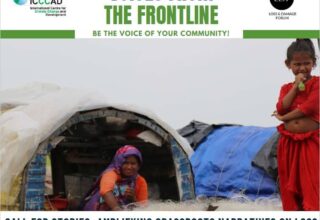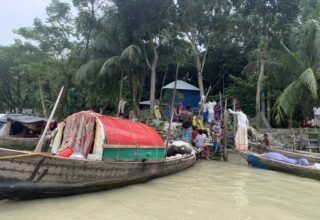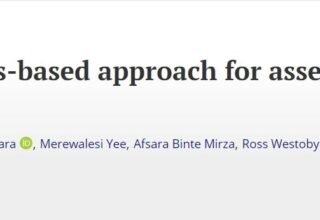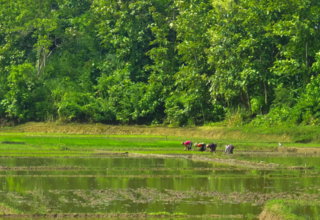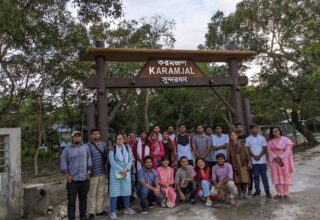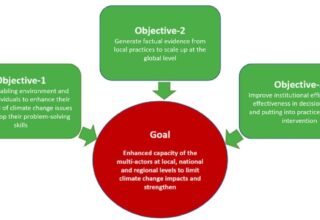(This article was originally published here)
Malnutrition in Bangladesh may have reduced significantly in the past 20 years, but more than 41% of its young children remain stunted due to chronic undernutrition. According to the World Food Programme, poor nutrition ultimately costs the country more than $1bn in lost productivity every year. Worryingly, the human and economic cost of poor nutrition are set to rise due to the effects of climate change, especially food insecurity, and an increase in natural disasters.
Nutrition is a highly complex field of science, and it interacts with public health in varied and sometimes unpredictable ways. Climate change-induced food insecurity, for example, could paradoxically lead to an increase in “over-nutrition” resulting in non-communicable diseases like heart disease and obesity. This is because, as food prices rise and food availability drops, people will be forced to survive on cheap, packaged, and processed food with low nutritional value, but a high fat and salt content.
Unfortunately, there is already a growing burden of non-communicable diseases in Bangladesh. Afflictions like heart disease, stroke, and chronic obstructive pulmonary disease are “diseases of affluence” that, until recently, typically affected overweight and obese people in high-income countries. However, according to the 2013 Global Burden of Disease Study, they are the leading causes of death in Bangladesh, accounting for 34% of all deaths despite the fact that many people are still underweight and food-insecure.
Dr Sabrina Rasheed, a scientist at the public health research organisation, International Centre for Diarrhoeal Disease Research, Bangladesh (icddr,b) who led a study on salt consumption in a coastal area of Bangladesh, has already seen how a changing environment can cause this to happen. Rising seas and excessive shrimp farming have made farmland salty, arid, and not fit for agriculture — local families have money to spend, she says, but there aren’t any fresh fruit or vegetables in the shops to spend it on.
Dr Rasheed also discovered that some people in these communities are consuming much more salt than the recommended daily limit because of the excess salt in their water and soil. The results were published in the study, “How much salt do adults consume in climate-vulnerable coastal Bangladesh?” This alone puts them at a higher risk for potentially fatal diseases like hypertension.
More disturbingly, a recent paper in the leading science journal Nature has claimed that climate change will make food that is grown less nutritious. Staples like wheat and rice, from which people in Bangladesh get over 75% of their dietary zinc and iron, will lose up to 9% of their zinc and 5% of their iron content because of high carbon-dioxide levels in the air. Carbon-dioxide is produced when fossil fuels are burned, and it has now built up to toxic levels in the Earth’s air, soil, and water.
Loss of nutrients could have serious implications for pregnant women and their young children, especially in countries with a poor nutritional record. Iron-deficiency anaemia is already common during pregnancy in Bangladesh, affecting up to 50% of women, and zinc deficiency has been associated with birth complications like uterine infections. Both of these nutritional deficiencies put the mother at risk for maternal mortality and can result in low-birth weight or premature birth for their babies — big risk factors for death in early childhood.
The matter is made worse by the fact that vitamin supplements and fortified foods alone do not always help to improve health outcomes. Numerous studies have shown that dirty water, weak sanitation infrastructure, and poor hygiene practices have a clear correlation with undernutrition, because subsequent diarrhoeal infections prevent the body from absorbing nutrients.
For example, a team of international scientists — including top nutritional scientists at icddr,b — recently discovered that chronic diarrhoeal disease during early childhood can permanently impair a child’s ability to absorb nutrients from food. Reported in Nature — “Population health: Immaturity in the gut microbial community” — this relationship could determine whether they suffer from a lifetime of nutritional deficiency, leaving them at risk for impaired brain development and non-communicable diseases in later life.
This is all the more concerning in light of the prediction that Bangladesh will suffer from increasingly common and severe floods as climate change progresses. As flooding increases, so too will cases of diarrhoeal disease.
The interplay between climate change and nutrition is complex and unpredictable, making it ripe for more research to help understand the impacts and best interventions in public health.
Written by: Joanna Lovatt and Jocalyn Clark; Joanna Lovatt is senior international fellow and Jocalyn Clark is executive editor at icddr,b in Dhaka, Bangladesh.
Photo: Nutritional interventions like the nutritionally-optimised diet pictured above combine a mixture of protein, carbohydrate, lipids and vitamins, and minerals.
Photo source: ICDDR,B.

